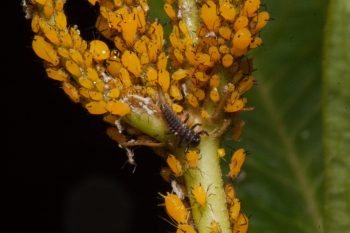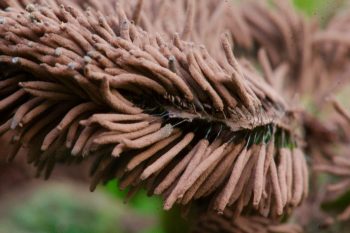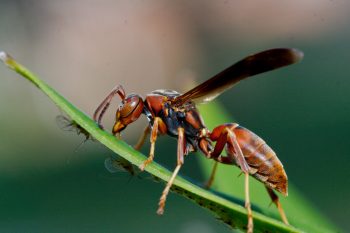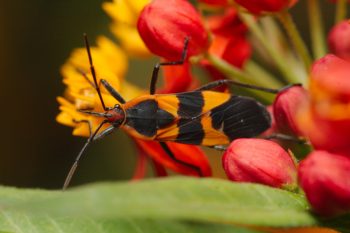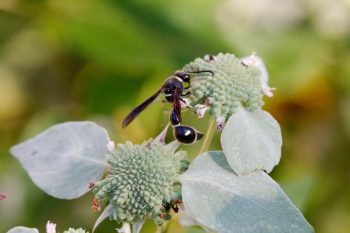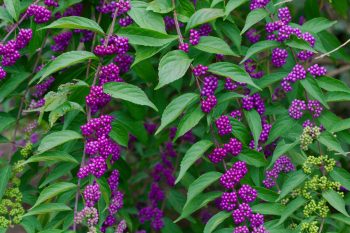I was out photographing flowers this evening. The light was fading and I didn’t think I could realistically get any photos of bees, wasps, or other flying insects. I was down on the ground to get some pictures of obedient plant, Physostegia virginiana, and I happened to notice this little fellow. I went in and got my flash, so I could get pictures that were worth something and I’m pretty happy with the results. This little bug (a true bug in the Heteroptera suborder) is only two or three millimeters long and if I hadn’t been down on the ground and very close, I never would have seen it. It is a twice-stabbed stink bug, Cosmopepla lintneriana. This one happens to be a nymph (an immature) and when adult will be mostly black with two red patches (the two “stab” marks of its common name).
Monthly Archives: September 2019
Cosmopepla lintneriana (Twice-stabbed Stink Bug)
Aphids and Lady Beetle Larva
I mentioned the aphids on the Asclepias curassavica (scarlet milkweed) when I posted the photo of the large milkweed bug a few days ago. Here’s a picture of the aphids. It was fairly dark when I took this (7:45 in the evening) and I used a flash to light them, which allowed me to get reasonable depth of field. I used a flashlight give me enough light to focus, with the camera on a tripod (which I definitely should use more often). As I was taking the pictures, I realized the aphids were not alone. There is a larva of a lady beetle of some sort (probably an Asian lady beetle, Harmonia axyridis), feeding on the aphids. Unfortunately, there are too many aphids for this lone predator, and I’m going to need to take care of them myself.
Stemonitis splendens (Chocolate Tube Slime Mold)
Cathy spotted this growing in our back yard and said I should come take some pictures. It was late in the day and the light was fading so they didn’t turn out as well as I would have liked. These are the sporangia of a slime mold (or mould in England). I believe it is Stemonitis splendens, the so-called chocolate tube slime. These don’t do any harm to garden plants, despite their somewhat alarming appearance. They actually live on the surface of leaves and are not actually parasitic. They feed on decaying organic matter and actually move in a way that seems more animal than vegetable. They form finger-like projections which then pull the body of the slime mold along. Creepy (literally!). From the Mississippi State University Extension Service:
When the slime mold is ready to reproduce, at some point during spring or summer generally following a period of rainy weather, it “crawls” up on grass blades, lower stems and foliage of landscape plants, the surface of landscape mulch, or even garden hoses. From these locations, the slime mold releases millions of dusty-gray spores.
Lunch with George and Carmela
Cathy and I drove up to George and Carmela’s today for a short visit. We had no trouble with traffic and we made pretty good time. We didn’t stay long but George had prepared a really nice lunch with homemade sourdough bread with robust olive oil spread on it and then covered with ripe, fresh tomatoes and sprinkled with feta cheese and Sicilian oregano. Obviously there are a lot of good flavors but fresh, very ripe tomatoes, served at room temperature, have to be right up there. These were wonderful and the corn on the cob as good, too. Of course, the visit was the main thing, and it was nice to have a few hours together before we turned around and drove home.
Paper Wasp
There are a few paper wasps that are very difficult to distinguish and some that are impossible without examining them at the microscopic level. A number of them are quite variable, as well, adding to the difficulty. I think this is a northern paper wasp (Polistes fuscatus) but I’m nowhere near sure. It’s a beautiful creature, whatever it is. This was taken with my 100mm lens with the addition of a 25mm extension tube in bright evening sunlight. As you can see, I was able to get fairly close and I’m pleased by how sharp this turned out. You might also notice the aphids on the underside of the leaf the wasp is on. I took some photos of those, as well, but haven’t identified them yet (beyond the generic “aphid”).
Oncopeltus fasciatus (Large Milkweed Bug)
It’s milkweed bug time in the garden. Cathy and I are both big fans of pretty much any species of Asclepias. This one is Asclepias curassavica, often known as scarlet milkweed. It’s growing in a container on our back patio and it really attracts the insects. I had a photo of a Monarch (Danaus plexippus) on it recently and today’s photo is of the aptly named large milkweed bug (Oncopeltus fasciatus). We also have a good colony of oleander aphids (Aphis nerii) and I may publish a photo of those, unless we get around to taking care of them before I do that. Like many insects that feed on milkweed, these bugs accumulate toxins from the plants which can “potentially sicken any predators foolish enough to ignore the bright colors which warn of their toxicity.” (bugguide.net)
Moon At Dusk
We had a pretty nice sunset this evening and I took a few pictures (aren’t you surprised?). Most of the best color was behind the trees to the south of our yard, so it was hard to capture. To the east there was some good color and I was able to get some nice pictures in that direction. To the west, most of the clouds were various shades of grey. There were a few low clouds that would light up and then go back to grey. I hoped to time the photo so that I could get both the moon and the lit clouds but they basically alternated. When the moon wasn’t behind the cloud, the color was mostly gone. Then the color would return just as the clouds covered the moon. This one has a little color in the clouds, anyway.
Eumenes fraternus (Potter Wasp)
This potter wasp (Eumenes fraternus) is one of my favorite wasps (doesn’t everyone have favorite wasps?). There’s fairly common around here. While they are particularly drawn to the mountain mint (Pycnanthemum muticum), they are also found regularly on the black-eyed Susans (Rudbekia) and painter’s palette (a.k.a. knotweed, Persicaria virginiana). I think it’s their clean lines that I like. They’re difficult to photograph well and I’m not really happy with this photo, although it’s the best I was able to get. They don’t really stop moving and unless the light is very strong, it’s hard to get both adequate depth of field and a short enough exposure to stop their motion.
Callicarpa americana (Beautyberry)
I’ve mentioned the beautyberry (Callicarpa americana) we have in our back garden so I thought it deserved a photo. Its berries are just about at the height of their beauty right now, so it seemed like the best time. As you can see, the berries are both beautiful and plentiful. Because this shrub blooms (and therefore sets berries) on new growth, it can be cut back fairly hard each autumn or early spring and it will still produce a good display. The flowers are not particularly significant, being tiny and very pale pink. The berries, as the name implies, are the reason to grow this native. It attracts birds, who eat the berries, which is also nice.
Cathy Weeding
Cathy and I have been trying to recover from the small amount of work we did in the garden in 2018. This year has been mostly recovery mode without a lot of additions but a lot of pulling and digging, trying to get at least some parts of the garden back to more garden plants than weeds. It’s an up hill battle. Along the back fence there was a huge stand of goldenrod, pokeweed, and bindweed. Cathy dug up a bunch of roots a few weeks back and we worked a bit more on it this weekend. As you can see, the central bed is full of black-eyed Susan’s and we have the volunteer American beautyberry (Callicarpa americana) growing there (the purple berries on the left). We dug out a bunch of weeds there last week, as well. Tomorrow I plan to dig up some roots that remain from the maple trees that used to be there.


